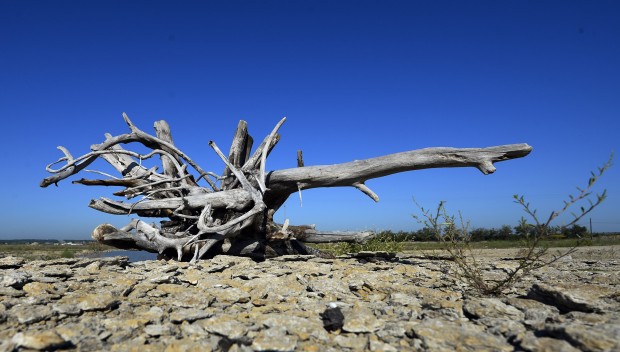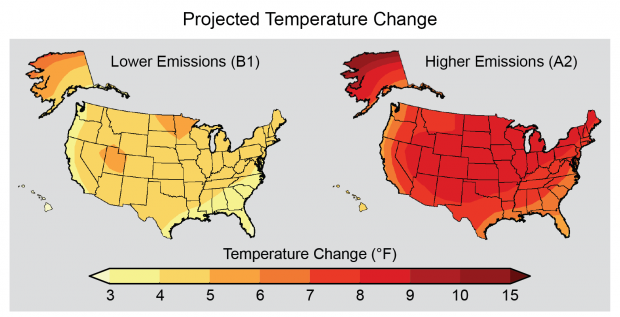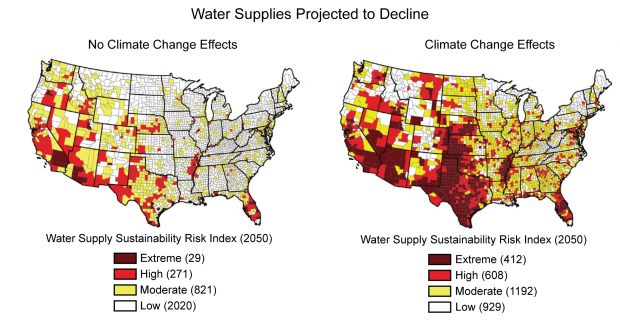More Drought, Heat and Water Wars: What Climate Change Already Means for Texas

EPA/LARRY W. SMITH /LANDOV
A tree trunk is exposed where water used to be in Bridgeport Lake, which was over thirty feet (9 meters) below normal levels, in Bridgeport, Texas, in September 2013.
A new federal report out today from offers a stark warning about our changing climate. As carbon dioxide reaches levels never before seen during human history, we’re already feeling the effects of climate change, and it’s likely to get worse.
The National Climate Assessment is the product of hundreds of experts and scientists, organized by the U.S. Global Change Research Program. They claim it’s “the most comprehensive, authoritative, transparent scientific report on U.S. climate change impacts ever generated.”
The report focuses on current and future climate change impacts to the U.S. For Texas and the Great Plains region, climate change caused by carbon emissions will exacerbate the issues the region has long faced: droughts, heat waves, storms and flooding. Agriculture will suffer, water wars will increase, and it’s going to get even hotter.
Climate scientists liken the impacts of climate change on weather to steroids: take a place like Texas already known for extreme weather, and then imagine if it started juicing. Our region is already known for “floods, droughts, severe storms, tornadoes, hurricanes, and winter storms,” the report says. It’s a dry region that needs more water than nature provides. “These variable conditions in the Great Plains already stress communities and cause billions of dollars in damage; climate change will add to both stress and costs,” the report says.
The report stresses that the impacts of global climate change aren’t something to dread only in the far-off future. They’re starting to be felt now — one need only think back to the record drought and heat of 2011. Water loss rates that year were “double the long-term average, depleting water resources and contributing to more than $10 billion in direct losses to agriculture alone,” the report says.
During that hellish year, “temperature extremes were attributable in part to human-induced climate change (approximately 20% of the heat wave magnitude and a doubling of the chance that it would occur). In the future, average temperatures in this region are expected to increase and will continue to contribute to the intensity of heat waves.”
Along the coast, climate change will result in rising sea levels, extreme high tides, and storm surges. Think back to the Galveston Bay oil spill last month, that closed a major shipping lane for days. Now imagine what a few hurricanes could do.
“Texas’ Gulf Coast averages about three tropical storms or hurricanes every four years, generating coastal storm surge and sometimes bringing heavy rainfall and damaging winds hundreds of miles inland,” the report says. “The expected rise in sea level will result in the potential for greater damage from storm surge along the Gulf Coast of Texas.”
Then there’s the temperature increases. Those sweltering summer days over 100 degrees? You can expect more of those, and in turn “increases in surface water losses, heat stress, and demand for air conditioning,” the report states. Whatever benefit we get from warmer winters will be negated by these extremely hot summers, according to the report.

National Climate Assessment
Temperatures have already increased nearly two degrees since record-keeping began, with most of that increase happening since the 1970s. And it's going to get even hotter.
In fact, it’s going to get so warm in the region that the growing season will be nearly a month longer on average. “We’re going to have to change the way that we grow our crops and manage our livestock if we’re going to be able to adapt to a changing climate,” Katharine Hayhoe, Director of the Climate Science Center at Texas Tech, says. Hayhoe authored the chapter of the report on climate change science.

National Climate Assessment
Water resources will continue to decline as the earth gets warmer, leading to more conflicts over a resource we already do not have enough of.
More heat and less rain means more evaporation in Texas. Dry spells will get longer, up to five more days on average by the middle of this century. That will “decrease water supplies, reduce electricity transmission capacity, and increase cooling demands,” according to the report. “These changes will add stress to limited water resources and affect management choices related to irrigation, municipal use, and energy generation.”
And when it does rain, you can expect it to sometimes rain too much. “In many places around Texas, we are seeing heavy precipitation events on the rise,” says Hayhoe. “We are really reeling from one extreme to the other, and these natural patterns we’ve always seen before are being exacerbated by a changing climate.”
Hayhoe says the big takeaway for the Lone Star State is that our water, agriculture and energy are all going to be affected in big ways. The report urges individuals and governments to start adapting now because solutions to climate change remain elusive.
Read the National Climate Assessment’s findings for the state of Texas:
